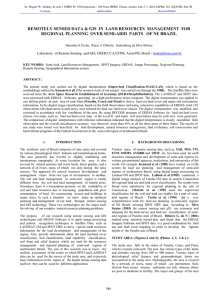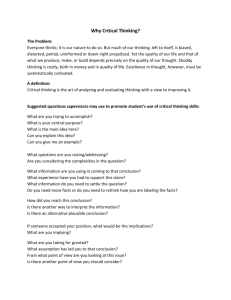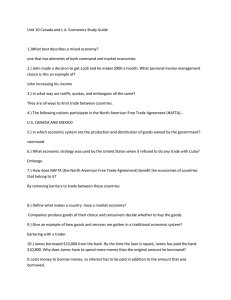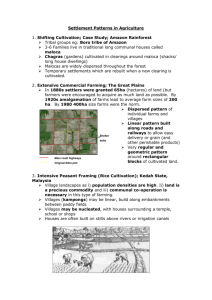SUPERVISED CLASSIFICATION TO LAND COVER MAPPING ... ENVIRONMENT OF NE BRAZIL USING LANDSAT-TM AND ...
advertisement
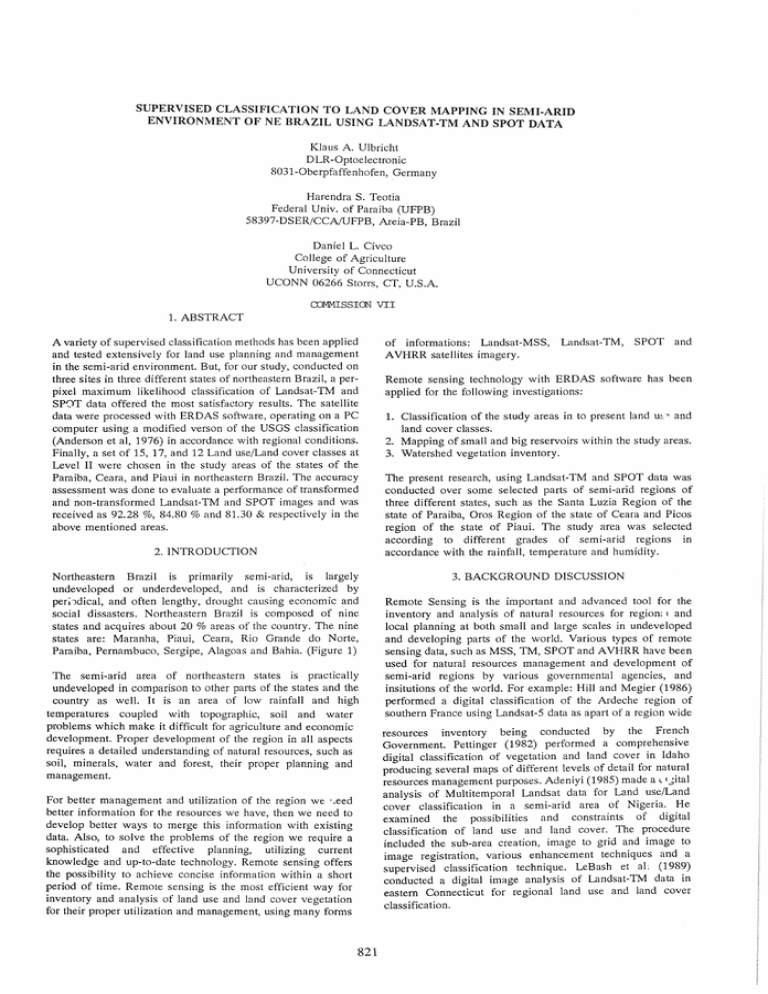
SUPERVISED CLASSIFICATION TO LAND COVER MAPPING IN SEMI-ARID ENVIRONMENT OF NE BRAZIL USING LANDSAT-TM AND SPOT DATA Klaus A. Ulbricht D LR -Optoelectronic 8031-0berpfaffenhofen, Germany Harendra S. Teotia Federal Univ. of Paraiba (UFPB) 58397-DSER/CCAlUFPB, Areia-PB, Brazil Daniel L. Civco College of Agriculture University of Connecticut UCONN 06266 Storrs, CT, U.S.A. COMMISSION VII 1. ABSTRACT A variety of supervised classification methods has been applied and tested extensively for land use planning and management in the semi-arid environment. But, for our study, conducted on three sites in three different states of northeastern Brazil, a perpixel maximum likelihood classification of Landsat-TM and SP0T data offered the most satisfactory results. The satellite data were processed with ERDAS software, operating on a PC computer using a modified verson of the USGS classification (Anderson et aI, 1976) in accordance with regional conditions. Finally, a set of 15, 17, and 12 Land uselLand cover classes at Level II were chosen in the study areas of the states of the Paraiba, Ceara, and Piaui in northeastern Brazil. The accuracy assessment was done to evaluate a performance of transformed and non-transformed Landsat-TM and SPOT images and was received as 92.28 %, 84.80 % and 81.30 & respectively in the above mentioned areas. 2. INTRODUCTION Northeastern Brazil is primarily semi-arid, is largely undeveloped or underdeveloped, and is characterized by per;')dical, and often lengthy, drought causing economic and social dissasters. Northeastern Brazil is composed of nine states and acquires about 20 % areas of the country. The nine states are: Maranha, Piaui, Ceara, Rio Grande do Norte, Paraiba, Pernambuco, Sergipe, Alagoas and Bahia. (Figure 1) The semi-arid area of northeastern states is practically undeveloped in comparison to other parts of the states and the country as well. It is an area of low rainfall and high temperatures coupled with topographic, soil and water problems which make it difficult for agriculture and economic development. Proper development of the region in all aspects requires a detailed understanding of natural resources, such as soil, minerals, water and forest, their proper planning and management. For better management and utilization of the region we '.eed better information for the resources we have, then we need to develop better ways to merge this information with existing data. Also, to solve the problems of the region we require a sophisticated and effective planning, utilizing current knowledge and up-to-date technology. Remote sensing offers the possibility to achieve concise information within a short period of time. Remote sensing is the most efficient way for inventory and analysis of land use and land cover vegetation for their proper utilization and management, using many forms 821 of informations: Landsat-MSS, AVHRR satellites imagery. Landsat-TM, SPOT and Remote sensing technology with ERDAS software has been applied for the following investigations: 1. Classification of the study areas in to present land u~' and land cover classes. 2. Mapping of small and big reservoirs within the study areas. 3. Watershed vegetation inventory. The present research, using Landsat-TM and SPOT data was conducted over some selected parts of semi-arid regions of three different states, such as the Santa Luzia Region of the state of Paraiba, Oros Region of the state of Ceara and Picos region of the state of Piaui. The study area was selected according to different grades of semi-arid regions in accordance with the rainfall, temperature and humidity. 3. BACKGROUND DISCUSSION Remote Sensing is the important and advanced tool for the inventory and analysis of natural resources for region, I and local planning at both small and large scales in undeveloped and developing parts of the world. Various types of remote sensing data, such as MSS, TM, SPOT and AVHRR have been used for natural resources management and development of semi-arid regions by various governmental agencies, and insitutions of the world. For example: Hill and Megier (1986) performed a digital classification of the Ardeche region of southern France using Landsat-5 data as apart of a region wide resources inventory being conducted by the French Government. Pettinger (1982) performed a comprehensive digital classification of vegetation and land cover in Idaho producing several maps of different levels of detail for natural resources management purposes. Adeniyi (1985) made a ll.;ital analysis of Multitemporal Landsat data for Land uselLand cover classification in a semi-arid area of Nigeria. He examined the possibilities and constraints of digital classification of land use and land cover. The procedure included the sub-area creation, image to grid and image to image registration, various enhancement techniques and a supervised classification technique. LeBash et al ~ (1989) conducted a digital image analysis of Landsat-TM data in eastern Connecticut for regional land use and land cover classification. addition to the field investigation in separating the soil units in a soil survey program. Teotia et al (1990) used digital image processing and GIS technologies for natural resources monitoring and evaluation for a part of NE Brazil and found that the integration of two technologies is a more suitable means for the management and development of any semi-arid region in a short period of time. Teotia et al (1991) have used the SPOT HRV data for land use/land cover and soil/land classification in the state of Piaui of northeastern Brazil and found it an inexpensive means of mapping natural resources over large areas. Hui et al (1991) used the remote sensing techniques cohining with ecological and geological information and, digital analysis system to produce a series of systematic, convincing and synthetic maps for a part of China. Ulbricht et al (1991) used the SPOT HRV for optical and digital analysis for the development of northeastern Brazil. Narayanan et al (1992) classified the soils using Mid-Infrared Off-Normal Active Differential Reflectance Characteristics. The soil samples were characterized in terms of the soil taxonomy, mineralogy, geographic location, soil texture, and organic carbon content. They found that these soils have unique reflectance signatures in the 9-11 Jim mid-infrared region. Maselli et al (1992) used the Landsat-TM data for Land Cover Classification with the Maximum Likelihood Classifer analysis. Figure 1: Study sites in northeastern Brazil. 1.in Paraiba state, 2.in Piaui state, 3.in Ceara state. The location of the Northeastern Brazil is shown on the inset.map of·Brazil. 4. PROCEDURE 4.1 Study Area The area known as northeastern Brazil comprises nine states: Maranha, Piaui, Rio Grande do Norte, Paraiba, Pernambuco, Sergipe, Ceara, Alagoas, and Bahia. It is quite large, covering approximately 20 % of the total fJrea of Brazil. In the first stage of this research, three selected areas have been studied in the states of Paraiba, Ceara and Piaui. After completing this research, similar methodologies will be used to study all other states of the region. This methodology is being taught in different universities of the region by seminars and trainings. The entire area and areas selected for study in the first stages of this research are shown in Figure 1. Civco (1989) concluded that knowledge-based image analysis for classifying Landsat Thematic Mapper region-based spectral data, coupled with ancillary digital spatial information, is not only feasible but also preferable to the per-pixel, spectral data only, statistical methods more traditionally employ, ( in deriving land use and land cover information for natural resources management. Johnson (1989) developed a digital map based a Hydrologic modeling System (MAPHYD) and applied it to the urban watersheds studies. Zhou (1989) developed a Relational Image -based GIS (RIGIS) for interfacing GIS and remotely sensed data for land resources studies in the arid zone of Australia. The study area is mainly semi-arid and has various types of dry lands with elevation ranging from 200 to 900 mders. Various types of physiographical relief features and geomorphical forms such as alluvial plains, cultivated fields, hills, inselbergs, rock ridges and grassy plains are encountered. Lyle and Stutz (1989) described systematic methods using GIS and remote sensing for rural land planning which formed the basis for land use planning for the areas of southern California. Teotia et al (1988) have made a comprehensive study for land use planning in semi-arid regions of northeastern Brazil, using SPOT HRV data. Kennard et al (1988) worked on a GIS system for land use planning and management of semi-arid regions of northeastern Brazil, using digital image proC\ :, ,ing on Landsat-TM and SPOT data. Crop production in the area is dependent principally on natural rains as little of the area is irrigated with water that has been collected in ponds and lakes during the rainy season. The area is also covered by natural pastures, wastelands, xerophytic vegetation and a network of rivers, many of which run only during the rainy season. Sirindhorn et al (1990) using unsupervised and supervised classifications of Landsat-TM data found that Landsat-TM data with its high resolution provide very satisfactory results in mapping land use/land cover. Ripple (1987) provided specific examples involving water, soil and vegetation resources management applications based on the integrated use of GIS and Image Processing Technologies. Agbu and Nizeyiman (1991) used the textural features for delineation of map units in the initial phases of detailed soil survey program and land use planning and prepared a spectral soil map to use an useful Soils derived from recent stream sediments in the area are rich, whereas others are poor to moderate in their natural fertility. The soils range from moderately shallow to very deep. The major soil associations are Entisols, Alfisols, Vertisols, Inceptisols, Utisols, and the Lithic subgroups of various orthers and rock outcrops. Crop production and animal husbandry are the major agricultural and economic activities of the [. t ion. The principal crops of the region are maize, beans, cotton, sugarcane and sisal; animals raised are goats, sheep, and cows. 822 training area selection for land use and land cover features of interest. These reference data, supplemented by field visits, also served as the basis for accuracy assessment to the computer-assisted, satellite-derived earth resources maps \:Ilich were prepared. The field studies conducted in Paraiba, Ceara and Piaui provided the ground truth reference data necessary for land use and land cover classification of SPOT and Landsat-TM multispectral data. Forty to fifty unique sites were visited in each study area, and observations for land cover, land form, vegetation, soil and slope were made. These observations were used to calibrate a supervised classification of the Landsat-TM and SPOT data. 4.2 Components required Data about the various components required for the research were gathered from sources as follow: 4.2.1 Land use and vegetation From aerial photographs, topographic maps, field observation, satellite data (Landsat-TM and SPOT) and IBAMA (Instituicao Brasileiro de Meio Ambiente). 4.2.2 Soils Based on the field observations, 41, 33, and 44 training areas were selected in the study areas of the Paraiba, Piaui and the Ceara states, using the interactive capabilities of image analysis systems for the land cover classes of interest. The relevant statistic (Le. means, and variance/covariance matrices) were generated for these training areas and finally a maximum likelihood classification was applied to the entire 512 by 512 pixel image, whereas other classifications such as Minimum Distance and Mahalanobis Distance were also tried. But for our purposes the maximum likelihood classification gave the most satisfactory results. After inspection of the initial classification, certain categories were aggregated and others deleted to reduce potential misclassification while still retaining maximum amount of information. This resulted in the final classification of 15, 17 and 12 categories at Le\ ~ I II. These Level II classes are shown in the modified classification hierarchy given in the Table 1, 2, and 3. From aerial photographs, soil survey maps at the small scales of Brazilian and FAO/UNESCO systems, soil survey technical reports prepared by various companies and institutions, and by field surveyy. 4.2.3 Slope and elevation From the topographic maps of SUD ENE (Superintendencia de Desenvolvimento de Nordeste), field observations, and the USDA system. 4.2.4 Climate Precipitation, temperature and humidity data collected from the EMBRAPA (Empresa Brasileira de Pesquisa Agrocuaria) in Campina Grande, Fortaleza and Teresina, and the F' ",leral universities of each state. 4.4 Criteria for Land use and Land cover classification CLand use planning) 4.2.5 Aerial Photographs and Satellite data Aerial photographs from Secretariates of each state, LandsatTM were taken from INPE (Sao Jose dos Campos, SP), EOSAT (USA), DLR (Germany) and SPOT from SPOT Image Corp. (France) and DLR (Germany). Land use planning processes that apply to the problems of developing countries are somewhat different to those used in developed countries. Economic development, agricultural production and the provision of basis housing and service facilities are problems of high priority in a semi-arid part of northeastern Brazil. However, although planning problems and priorities are substantially different between develope<.. and developing nations, the structure of the planning process and the information requirements are essentially similar. Classification schemes are needed therefore which represented these facets clearly and unambioguously. The expandable land use/land cover system devised by the United States Geological Survey (Anderson et ai, 1976) is generally accepted worldwide and is being used in a number of operational mapping programs of both developing nations. With two levels of detail (Level I and II), it can be used with remotely sensed data at various resolutions and scales. It serves also as a framework for more detailed regional and local classification systems because it is sufficiently inclusive. For our study of the semiarid regions of northeastern Brazil. This classification system is being modified in accordance with the local climate, local needs and existing conditions. This system of classification can be extended to the more detailed Level III and IV through the use of large-scale aerial photographs and detailed ~ield observations. The work on land use/land cover for land use planning in Paraiba by Teotia and Ulbricht (1985) and Ulbricht and Teotia (1986) have also be considered. Also, the classification system prepared for the state of Connecticut (USA), as described in the "Interpretation of Aerial Photographs" (Avery and Berlin), (1985) had been tried to some extent to classify the remote sensing data to Level III of the USGS system, but did not give satisfactory results. 4.2.6 Municipality and state boundaries For municipality and state boundaries, the administrative units of each state and Mayor offices of the cities and the SUDcNE. 4.3 Data Processing and Image Interpretation The principal remote sensing image processing system used is ERDAS-the Earth Resources Data analysis System. ERDAS is a micro and minicomputer-based multipurpose, raster-oriented image analysis and GIS software system. At the Federal University of Paraiba (UFPB), ERDAS is installed on an Intel 80286-based super-microcomputer with a Number Nine Revolution image display system. This installation enables 512 by 512 by 32-bit full color image display with an 8-bit graphics overlay (a total of more than 16 million colors). A 1000 by 1000 pixel scene taken from a SPOT-1 HRV scene centered in the state of Paraiba and Piaui and the same size sub-scene of Landsat-TM centered in the state of Ceara, Brazil, were from a 9-track magnetic tape for subsequent analysis. A hybridized unsupervised-supervised classification approach was used for the analysis of land use/land cover and other earth resources information. The classification scheme was modeled after the United States Geological Survey system for use with remote sensing data (Anderson et aI, 1976), modified to account for local conditions within the study areas. Available reference data, such as aerial photographs, soil and land use maps and topographic maps were used to assist in supervised 823 Table 1: Paraiba Land UselLand Cover No. Symbol 1. 2. 3. 4. 5. 6. 7. 8. 9. 10. 11. W1 W2 W3 U1 U2 CF1 MF1 CP1 A1 A2 F1 12. F2 13. F3 14. F4 15. F5 Description Deep to very deep water Moderately deep to deep water Very shallow to shallow water Dense urban area Sparse urban and barren rocky land Cotton cultivated and fallow land Mixed cultivated and fallow land Mixed cultivated and pasture Alluvial with dense shrubs/trees Alluvial cultivated and eroded land Sparse caatinga forest and rocky land Sparse to mode. dense caatinga forest Mode. dense to dense caatinga forest Dense caatinga mixed forest on undulating land. Dense caatinga and mixed forest on hills Total Pixels % 3.137 2.994 5.275 11.469 23.013 29.571 19.821 106.L,") 17.943 42.429 49.884 0.3 0.3 0.5 1.2 2.3 3.0 2.0 10.7 1.8 4.2 5.0 285.754 28.6 84.347 8.4 147.773 14.8 170.111 17.0 1.000.000 100.00 Table 2: Piaui Land uselLand cover No. Symbol 1. 2. 3. 4. WO W1 W2 W3 5. 6. SFA UO 7. 8. EFA PDC 9. 10. 11. 12. PDC1 MC RB RB1 13. SCD 14. WERM 15. DCF 16. MDCF 17. SPC Total: Descripiton Deep clear water Moderately deep water Shallow silted water Very shallow water or mostly moist area Swampy flooded area Urban area with barren rocky land Eroded flooded area Poor drained cultivated and eroded land Poor drained cultivated Alluvial mixed cultivated Cultivated river bed Cultivated river bed with dense shrubs and vegetation Saline cultivated depression Weathered eroded rocky and moist land with sparse vegetation Dense caatinga forest Mode. dense caatinga forest on undulating topography Sparse caatinga forest on undulating and eroded topography with poor cultivation Pixels % 1.291 248 165 298 0.49 0.09 0.06 0.11 4.534 13.522 1.73 5.16 52.348 17.006 19.97 6.49 15.208 25.849 2.389 4.116 5.80 9.86 0.91 1.57 1.966 10.574 0.75 4.03 27.302 45.227 10.41 17.25 40.101 15.30 262.144 100.00 824 Table 3: Ceara Land uselLand cover No. Symbol 1. 2. 3. 4. 5. 6. 7. WI W2 W3 W4 VI C1 C2 8. Al 9. A2 10. F1 11. F2 12. F3 - Description Deep to very deep water Moderately deept to deep Shallow silted water Shallow and polluted water Urban area with rock outcrops Cultivated nearly level land Sparse to mode. cultivated undulating land Alluvial mode. to dense cultivated land Alluvial mode. cultivated and eroded undulating land Dense caatinga forest on hills Mode. dense caatinga forest on undulating topography Sparse caatinga forest on eroded shallow and undulating land Total: Pixeb % 29.340 15.606 17.568 2.770 16.885 106.569 207.654 2.93 1.56 1.76 0.28 1.69 10.66 20.77 113.948 11.39 107.670 10.77 7.090 57.421 0.71 5.74 317.479 31.75 1.000.000 100.00 During the conduct of this project, we used the following important criteria suggested by the USGS: 1. Interpretation accuracies in the identification of land use and land cover categories from remote sensor data should be 85 % or greater. 2. The classification system should be applicable over extensive areas. 3. The categorization should permit vegetation and other types of land cover to be used as indicators of activity. 4. Multiple uses of land should be recognized where possible. 5. The classification system should be suitable for use with remote sensor data obtained at different times of the year and in different years. In addition, the following criteria suggested by Colomb, Kennard and Civco (1985) and by Civco and Kennard (1983) were also considered: 1. Individual land use and cover classifications ShOUld be customized to facilitate interpretations of digital images with different resolutions. 2. To reduce processing costs and increase accuracy, digital images should be classified and then corrected geometrically. 825 5. RESULTS AND DISCUSSIONS Comparison of digital interpretation with reference information indicated that digital interpretation closely resembled field observations. A more rigorous quantitative measure of accuracy performed using the test areas, however, indicated that some categories were classified and mapped more reliable than others. The overall classification accuracy in all the three test sites was as 92.28 %, 84.7 % and 81.3 % respectively in the states of Paraiba, Piaui and Ceara. In the study area of the Paraiba State, the deep to very deep water (WI); moderaly deep to deep water (W2); very shallow to shallow water (W3), sparse urban and barren, rocky ,and (V2); alluvial cultivated and eroded land (A2); sparse to moderately dense caatinga forest (F2); moderately dense to dense caatinga forest (F3); dense caating forest on undulating land (F4) and dense mixed caatinga forest on hills (F5) classes produced the best results in terms of high percentages agreement with ground truth data (80.0-100 %) and relatively low percent commissions (0.0-12.3 %). This shows that digital data of these classes are spectrally homogeneous and can be discriminated readily from other classes. Other classes such as dense urban area (Ul), mixed cultivated and fallow land (MFl), and mixed cultivated and pasture (CPl) are more spectrally hetegoreneous and explain the low overall classification accuracies and high commission percentages. The cotton cultivated and fallow land (CF1) and alluvial land with dense shrubs/trees (Al) classes also yielded a high agreement relative to the ground truth data (88.2 % and 77.6 %). The corresponding percentage commissions, however, were higher at 36.4 % and 19.5 %, respectively. Most commission errors for the cotton cultivated and fallow land and for alluvial land with dense shrubs/trees were due to confusion with the alluvial cultivated eroded land and the mixed cultivated and pasture classes. This was due to the spectral variability and sometimes sililarity among these classes. 6. GENERAL CONCLUSIONS In case of the state of Piaui, the deep clean water (WO); moderately deep water (WI); shallow silted water (W2); swampy flooded areas (SF A); eroded flooded areas (EFA); poor drained cultivated and eroded land (PDC); alluvial mixed cultivated (AMC); cultivated river bed (CRB); cultivated river bed with dense shrubs/vegetation (CRB 1); saline cultivated depressions (SCD); and dense caatinga forest (DCF) classes produced the best results in terms of high percent agre . . ~,lent with ground truth data (78-100 %) and relatively low percent commissions (0.01-11.7 %). This indicates that the digital data of these classes are spectrally homogeneous and easily have been discriminated from other classes. The other classes such as very shallow water or mostly moist areas (W3); urban areas with barren rocky land (UO); weathered eroded rocky and moist land with sparse vegetation (WERM); moderately dense caating forest on undulating topography (MDCF); sparse caatinga forest on undulating and eroded topography with poor cultivation (SPC) are more spectrally heterogeneous and explain the lower overall classification accuracy (57.87 to 75.73 %) and high commissions percentage of (25.21 to 49.73 %). Digital interpretations of Landsat-TM and SPOT with 30m and 20m resolution imagery proved to be effective in determining detailed assessment of land use and land cover classes for some selected areas of semi-arid regions of northeastern Brazil. The combination of unsupervised and supervised classification of Landsat-TM and SPOT data for land use/land cover mapping and map accuracy assessment provided satisfactory results. In terms of operational reliability, the per pixel maximum likelihood classification of Landsat-TMand SPOT image data offered the most satisfactory results in comparison to other classification systems. To get more information about the land use and land cover classes the multitemporal LandsatTM and SPOT images from several seasons are necessary. 7. LITERATURE CITED Adeniyi, P.O. 1985. Digital analysis of Multitemporal L1ndsat Data for Land-UselLand Cover Classification in a Semi-Arid Area of Nigeria. In: Photogrammetry engineering and Remote sensing, Vol. 51. No. 11, pp.1761-1774. In case of the state of Ceara, deep to very deep water (\V1); moderately deep to deep water (W2); shallow silted water (W3); Urban areas with rock outcrops (U1); cultivated nearly level land (Cl); Alluvail moderately to dense cultivated land (AI); dense caatinga forest on hills (Fl) and moderately dense caatinga forest on undulating topography (F2) classes have shown the better results in terms of high percentage agreement with ground truth data (76-100 %) and relatively low percent commissions (0.09-15.8 %). These results show that the digital data of these classes are spectrally homogeneous and easiliy are being discriminated from other classes of the region. The other classes such as shallow and polluted water (W4); sparse to moderately cultivated undulating land (C2); alluvial moderately cultivated and eroded undulating land (A2) and sparse caatinga forest on eroded shallow and undulating land (F3) are more spectrally heterogeneous and explain the lower overall classification accuracy (53.83 to 71.82 %) ana .ligh commissions percentage of (23.80 to 47.72 %). From these results it is observed that the inability to discriminate among certain classes, is due to the spectral similarity between categories. It is a common problem with the pattern recognition (maximum likelihood classification) method dealing with per pixel spectral data alone. Other spatiallyoriented data are required to augment and enhance the classification process (Civco, 1987). Also, the limited range of the SPOT HRV sensor may not permit adequate spectral discrimination of the classes being mapped. The discrimination among the classes of the Landsat-TM data was far better because of the wide range of spectral regions. The classification demonstrated that the percentage accuracy is decreased as the level of detail is increased. The more spectrally hetereogeneous areas also reduce the acc":acy percentage of the classification. No quantitative accuracy assessment was made for these maps. Agbu, P.A. and Egibe Nizeyiman. 1991. Comparisons between spectral mapping units derived from SPOT image texture and field soil map units. In: Photogrammetric Engineering and Remote Sensing (ASPRS). Falls Church, Virginia, pp. 397-411. Anderson, J.R., E.e. Hardy, IT. Reach and R.W. Witmer. 1976. A land use and land cover classification system for use with remote sensing data. U.S. Geological Survey. Reston, Virginia (USA). Professional Paper 964. 28 pp., iIIus. Avery, T.E. and O.L. Berlin. 1985. Geographical information system and land use and land cover mapping. In: Interpretation of Aerial Photographs. Burgess Publishing Company, Minnesota (USA). pp. 235-267. Civco, D.L. and w.e. Kennard. 1983. A<;sessing land use change and predicting trends through discriminant and spatial data analysis. In: Proc. of the Int. Conf. on Renewable Natural Resources Inventories for Monitoring changes and Trends. Oregon State Univ., Corvallis, Oregon (USA). pp. 640-644. Civco, D.L. 1987. Knowledge -based classification of Landsat Thematic Mapper digital imagery. Ph.D. dissertation. The University of Connecticut, Storrs, Connecticut (USA). pp. 214. Civco, D.L. 1989. Knowledge-based land use and land cover mapping. Technical papers. 1989 ASPRS/ACSM. A,nual Convention. Baltimore, Maryland (USA). 3:276-293. Colomb, R.O., W.e. Kennard and D.L. Civco. 1985. The effects of spatial resolution on automated classification of land use and cover. In: Proc. 5th Conference of L' A<;sociation Quebecoise de Teledetection, Chicoutimi, Quebec (Canada). pp. 503-525. Hill, J. and Megier. 1986. Rural land use inventory and mapping in the Ardeche area using multitemporal TM data. IntI. Oeosci. and Remote Sensing Symp. Zurich (Switzerland). 2: 1135-1141. 826 Hui, A.H., Yan, G.H., Yun, H.T. and Yang Ming Jun. 1991. Study on the application of Remote Sensing Techniques in systematic mapping of natural resources and enviror ,,'ent. Proc. of 24th International Symposium on Remote Sensing of Environmental (ERIM), rio de Janeiro (Brazil). pp .... Teotia, H.S., Ulbricht, K.A., Civco, D.L., and W.e. Kennard. 1991. Utilization of SPOT data for land use/cover mapping and soil/land classification in the Piaui state of northeastern Brazil. In: Proc. of the XXIV ERIM Int. Conf. Rio de Janeiro (Brazil). pp .... Johnson, L.E. 1989. MAPHYD-A Digital Map-Based Hydrological Modeling System. In: Photogrammetric Engineering and Remote Sensing (ASPRS), Falls Church, Virginia. pp. 911-917 Teotia, H.S., Kennard, W.e., Civco, D.L. and K.A. Ulbricht. 1990. Digital image processing and GIS applications for natural resources monitoring and evaluation on northeastern Brazil. In: Proc. of ISPRS-Comm. VIr Midterm Convention, Victoria, (Canada). pp. Kennard, W.e., H.S. Teotia, and D.L. Civco. 1988. The role of an automated GIS in the development and management of renewable natural resources of northeastern Brazil. In: Proc. of ISPRS, Kyoto (Japan). pp. VII 220-231. LaB ash, e.L., D.L. Civco, and W.e. Kennard. 1989. The use of linearly transformed Landsat Thematic Mapper Data in land use and land cover classification. Technical Papers. 1989 ASPRS/ACMS Annual Convention, Baltimore, Maryland (USA). pp. 2:53-66. Lyle john and Frederick P. Stutz. 1989. Computerized Land Use Suitability Mapping. In: Photogrammetric Engineering and Remote Sensing (ASPRS), Falls Church, Virginia, pp. 66-76. Maselli, F., Conese, C., Petkov, L., and RaffaeIIo Resti. 1992. Inclusion of Prior Probabilities Derived from a Nonparametric Process into the Maximum-Likelihood Classifier. In: Photogrammetric Engineering and Remote Sensing (ASPRS), Vol. 58. No.2, pp. 201-207. Narayanan, R.M., Green, S.E., and Dennis R. ~lexander. 19:2. Soil Classification Using Mid-Infrared Off-Normal P~tl~e Differential Reflectance Charracteristics. In: Photogrammetnc Engineering and Remote Sensing (ASPRS), Vol. 58. No.2, pp. 193-199. Pettinger, L.R. 1982. Digital classification of Lands~t data. for vegetation and land cover mapping in the Blackfoot ~lver watershed, southeastern Idaho (USA). USGS ProfeSSIOnal Paper 1219, pp. 33. Ripple, W.J. (Ed.). 1987. GIS for Resources M,an~l~ement: A Compendium. ASPRS/ACSM, Falls Church, VirgInIa (USA). pp.288. Sirindhorn, H.R.H.P.M.e., Sapacharanan, S. and Korpin Srisuksawadi. 1990. L1nd use/land cover map a~curacy Assessment of Landsat Thematic Mapper Data usmr: the DIMAPS image processing system for Narathiwat Provmce, Thailand. In: GEOCARTO 1, 1990. Edited by John E. Estes. Dept. of Geography, Univ. of California, Santa Barbara, California (USA). pp. 15-24. Teotia, H.S. and KA. Ulbricht. 1985. Evaluation of Landsat Thematic Mapper data for generalized soil, land use and land cover classification in the semi-arid part of the state of Paraiba, Brazil. In: Proc. of the Tnt. Conf. of Remote Sensing, London (United Kingdom). pp. 131-140. Teotia, H.S., Kennard, W.e. and D.L. Civco. 1988. Optical and digital Interpretation of SPOT imagery for I~nd resources planning and managment in northeastern BraZIl. Proc. 16th ISPRS Congress, Kyoto (Japan). pp. VII 220-231. 827 Ulbricht, KA., and H.S. Teotia. 1986. Use of Landsat Thematic Mapper imagery for soil and Landuse Investigations in Paraiba, Brazil. In: Proc. of the XXth ERIM-Conference. Nairobi (Kenya). pp. 1059-1070. Ulbricht, KA., Teotia, H.S., Civco, D.L. and W.e. Kennard. 1991. A trilateral cooperation for the development of northeastern Brazil. In: Proc. of the 12th Asian Conference on remote Sensing Singapore (Singapore). pp. C-2-1 to C-2-6. Zhou qiming. 1989. A Method for Integrating Remote Sensing and Geographic Information System. In: Photogrammetric Engineering and Remote Sensing (ASPRS). Falls Church, Virginia., pp. 591-596.
